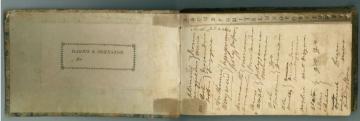This month we are featuring blog posts written by women studying at William & Mary, in recognition of Women's History Month. This post is written by Holly Gruntner, History PhD candidate.


Sometime between 1795 and 1826, Lady Jean Skipwith made an account of the flora on her property. [i] A pocket-sized notebook, now in the Special Collections Research Center (SCRC), contains her handwritten list of plants. These notes, while highly organized by way of the notebook's lettered tabs, are somewhat sparse. They make no explicit reference to Skipwith herself and include no lengthy descriptions. But what is there is striking in its own way and allows us to imagine not only the plants dotting Skipwith's property, but also Skipwith's process of recording them: "Almond," she wrote to begin the notebook. She flipped through her copy of Philip Miller's Gardeners Dictionary, which summarized Carl Linnaeus's system of plant taxonomy. Using the Gardeners Dictionary, Skipwith located the name of almond's genus: "Amygdalus."[ii] Misspelling it, she wrote, "Amygaldus." She added two more of the plant's characteristics, "Icosan" and "Mono," shorthand for Icosandria Monogynia, before moving on to the next "A" plant.[iii] Skipwith continued thus, until each letter of the alphabet had a set of entries, up to "Zea Indian Corn."[iv]
I first encountered Skipwith's notes in 2018, when I visited the SCRC to conduct research for a graduate seminar paper. What captured my interest then, as now, is the breadth of intellectual expression to be found in even the most abbreviated sources. Jean Skipwith was somewhat famously an avid gardener, but much of the remaining evidence of her botanical interest amounts to lists.[v] Besides her notebook, Skipwith created many lists on pieces of loose-leaf paper, with headings such as, "Peach stones burried at Prestwould Octo[ber] 1791," and "Bulbous roots to get when in my power."[vi]

Through these lists, we can see a whole world. "Claytonia," she wrote on one list, indicating the Linnaean genus. Next, she added her own description. Claytonia was not an abstract concept to Skipwith, but a "Pink narrow leafed Black rooted flower from the foot of the garden." Skipwith also noted vernacular names for plants. "Crythronium" was also "Dogs Tooth Violet," or "what we called Island Martagon." Skipwith's lists often included where each plant grew, whether by way of description ("the foot of the garden") or by numbering plants based on their spatial order. Through these practices, Skipwith created a botanical geography of her home, a map in which each plant was identified. In another instance, Skipwith reminds us that this bountiful geography could be fraught with competing classifications. Alongside "Meadow Saffron (Colchicum)," she – perhaps mirthfully – added that the plant was "called by the comm[on] people Naked Ladies."[vii]
Skipwith's lists are extraordinary sources. There are many of them, and the diverse plants she recorded reflect the broad expanse of her colorful world. Even the scrappiest scraps of lists in Skipwith's handwriting have been carefully saved. Her lists also served as my introduction to a major challenge of studying early modern science: figuring out what people thought, often without the benefit of verbose treatises, letters, or diaries. I am currently researching a dissertation on early American kitchen gardens, from 1650-1830. My research demonstrates the myriad ways ordinary people's gardens and gardening labors were manifestations of scientific knowledge, experiment, and exchange.
[i] Skipwith and her husband, Sir Peyton Skipwith, owned Prestwould Plantation, in present-day Clarksville, Virginia. After her husband's death in 1805, Jean Skipwith managed Prestwould. Her notebook isn't dated, but Skipwith probably wrote in it between 1791, when her papers make the earliest reference to the flora of Prestwould, and her death in May 1826.
[ii] Skipwith owned at least one edition of Philip Miller's popular garden text, The Gardeners Dictionary. Possibly the 8th edition (London: John and James Rivington, 1768). For this and more on Skipwith's books, see Mildred K. Abraham, "The Library of Lady Jean Skipwith: A Book Collection from the Age of Jefferson," The Virginia Magazine of History and Biography 91, no. 3 (July 1983): 320. Skipwith's Notebook is in Box 23, Folder 4, Skipwith Family Papers, SCRC.
[iii] See the first page of the "Amygdalus" entry in Miller, Gardeners Dictionary (1768) [pages not numbered]. This edition of Miller is online via the Biodiversity Heritage Library: https://www.biodiversitylibrary.org/page/394540. "Icosandria Monogynia" refers to a flower's reproductive organs: Icosandria denotes flowers with 20 or more stamens and Monogynia denotes flowers with one pistil.
[iv] Box 23, Folder 4, Skipwith Papers.
[v] Lisa Ann Flick offers a good account of what we know of Skipwith's biography. "Stretching the Bounds: Lady Jean Skipwith, Mistress of Prestwould, 1748-1826" (Master's Thesis, William & Mary, 1987).
[vi] Box 21, folder 32, Skipwith Papers.
[vii] Box 21, folder 32, Skipwith Papers.

